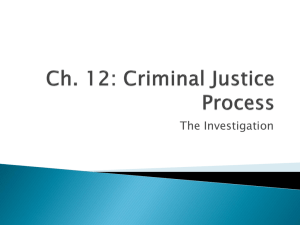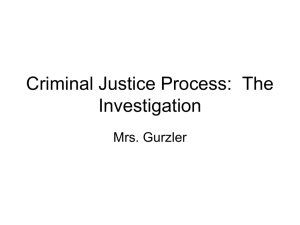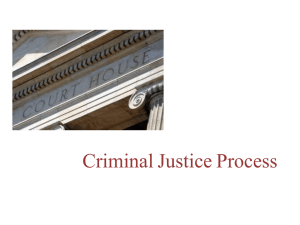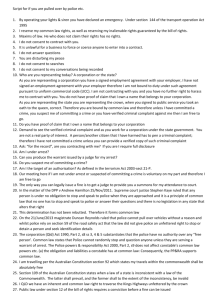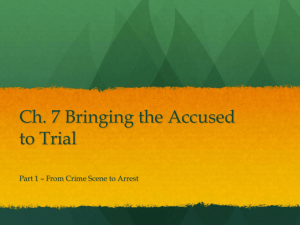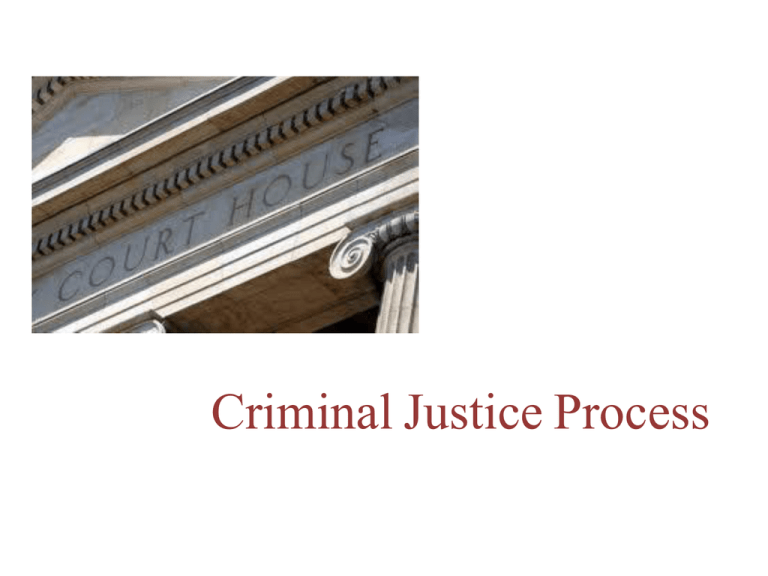
Criminal Justice Process
1. INVESTIGATION:
After a crime has been Discovered,
evidence is gathered and follow-up
investigations attempt to reconstruct
the sequence of activities leading up to and including the criminal
event. Efforts to identify suspects are initiated.
2. WARRANT: An arrest warrant issued by a judge provides the legal
basis for an apprehension of suspects by police.
3. ARREST: In an arrest, a person is taken into custody, limiting the
arrestee’s freedom. Arrest is a serious step in the process of justice.
During arrest and questioning, defendants are usually advised of their
constitutional rights, or Miranda Rights.
4. BOOKING: Booking is an administrative procedure where pictures,
fingerprints, and personal information are obtained.
5. FIRST APPEARANCE: Within hours of arrest
suspects must be brought before a magistrate (a judicial
officer) for an initial appearance. The judge will tell the
defendant of the charges against them, advise them of
their rights, and may provide the opportunity for bail.
6. PRELIMINARY HEARING : The prosecution must
produce evidence to show probable cause that the
defendant committed the crime. This step is sometimes
combined with the initial appearance. The next step
depends on if the crime is a misdemeanor or felony. If a
misdemeanor the judge will set a date for a trial. If a
felony the case will go before the grand jury. The grand
jury will decide if there is enough evidence to indict
(formally charge) the defendant.
THE INITIAL APPEARANCE: Must be held within 48 – 72 hours after
arrest in order to protect people from being put in jail and forgotten (habeas
corpus).
WRIT OF HABEA CORPUS: A writ that directs the person detaining a
prisoner to bring him or her before a judicial officer to determine the
lawfulness of the imprisonment.
7. INFORMATION: A formal, written accusation submitted to a court by
a prosecutor, alleging that a specified person has committed a specified
offense.
7a.INDICTMENT: A formal, written accusation submitted by the court by
a grand jury, alleging that a specified person has committed a specified
offense, usually a felony.
8. ARRAINGNMENT: The first appearance f the defendant before the
court that has the authority to conduct a trial. The accused stands before
a judge and hear the information, or indictment, against them as it is
read. Defendants are again notified of their rights and are asked to enter
a plea.
9. ADJUDICATION: A criminal trial may be held, or the defendant may
decide to enter a guilty plea. A criminal trial involves an adversarial
process that pits the prosecution against the defense. In most trials, a
jury hears the evidence and decides issues of guilt or innoncence, while
the judge ensures the
Fairness of the proceedings.
10. SENTENCING: After the person has been convicted it is up to the
judge to determine the punishment. Prior to sentencing, a sentencing
hearing is sometimes held in which attorneys for both sides can
present information to influence the judge’s decision.
11. CORRECTIONS: The corrections period begins following
sentencing. Corrections involves a variety of sentences that can be
imposed on a defendant. (Community Supervision, Community
Service, Jail Time, Prison Time, Treatment Programs).
12. REENTRY: Not everyone who has been convicted of a crime goes
to prison. Community Supervision (Probation) imposes requirements
or restrictions upon offenders. Offenders are required to check in with
a probation officer on a regular basis. After a defendant has served a
portion of his prison term he may be freed on parole. Like probation,
parole may come with obligations and requires the offender to check
in with a parole officer.
Absolute Certainty
Beyond a
Reasonable
Doubt
Criminal Jury Verdict
Non-Suggestiveness of
Identification
Clear and
Convincing
Civil Trial Decision
Preponderance
Take Case to a Jury
Arrest, Search,
Indictment,
Information
Stop, Frisk,
Question
Prima Facie
Probable Cause
Reasonable Suspicion
Mere Hunch
No Basis for Knowledge
Copyright © Texas Education Agency 2011. All rights reserved.
Images and other multimedia content used with permission.
7
Classifications of Crimes
• Class C Misdemeanor
– Fine up to $500 (ticket)
– Cannot be arrested
• Speeding or Open Container
• Class B Misdemeanor
– Up to 180 days in jail
– $2,000 fine
• Class A Misdemeanor
– Up to 2 years in jail
– $4,000 fine
8
Classifications of Crimes
State Jail Felony (SJF):
180 days to 2 years
$10,000 fine
3rd Degree:
2-10 years
$10,000 fine
2nd Degree:
2-20 years
$10,000 fine
1st Degree:
5-99 years
$10,000 fine
Capital:
Death
Life without Parole
Copyright © Texas Education Agency 2011. All9rights reserved.
Images and other multimedia content used with permission.
“Terry Frisk”
Terry v. Ohio
– Unusual Conduct
– May be armed and dangerous
– Protection of self and others
– Suspicion of crime and weapon to be used
– Careful pat of outer clothing
– Alone and no backup
– Emotions or behavior of suspects
10
Fourth Amendment
• “The right of the people to be secure in
their persons, houses, papers, and effects,
against unreasonable searches and
seizures, shall not be violated, and no
Warrants shall issue, but upon probable
cause, supported by Oath or affirmation,
and particularly describing the place to be
searched, and the persons or things to be
seized.”
11
Plain-View Doctrine
Coolidge v. New Hampshire
• The initial intrusion must be lawful or in
proper position to view the property.
• The discovery must be inadvertent.
• It must be immediately apparent that items
are evidence of a crime, contraband, or
subject to seizure
12
Exclusionary Rule
• CCP 38.23
• No evidence shall be admitted into a criminal
trial that was obtained in violation of
constitutional rights
• Mapp v. Ohio
– Illegally seized evidence could be excluded from
both state and federal cases
13
Fifth Amendment
•
•
•
•
•
Grand jury
Double jeopardy
Self-incrimination
Due process
Just compensation for government takings
14
Double Jeopardy
• Exceptions to Double Jeopardy
– Convicted and asks for a new trial
– Convicted and the case is overturned
– The case results in a hung jury
– Can be tried at both the state and federal levels
for the same crime
15
More On The 5th Amendment
• The Grand Jury indictment rule does not apply in a time
of war.
• You cannot be tried twice for the same offense.
• You cannot be forced to be a witness against yourself.
• You cannot be arrested, convicted, or executed without
due process of law.
• The government can seize your land but they have to
pay you just compensation. This law is referred to as
“Eminent Domain.”
Copyright © Texas Education Agency 2011. All rights reserved.
16
Images and other multimedia content used with permission.
Sixth Amendment
• Speedy and public trial
• Impartial jury
• Informed of the nature and cause
of the accusation
• Confrontation of witnesses
• Compulsory process of witnesses
• Right to an attorney
17
Eighth Amendment
• No excessive bail
• No excessive fines
• No cruel and unusual
punishment
18
Secure in Persons Against Unreasonable
Searches and Seizures
• Key = “probable cause”
• Probable Cause – an amount of reliable information indicating that it
is more likely than not that evidence will be found in a specific
location or that a specific person is guilty of a crime
• Reasonable Suspicion – certain events and/or circumstances make it
appear to a normal, prudent person for them to believe that a crime
has been or is about to be committed
• Mere Suspicion – a feeling that someone has or is about to commit a
crime
Copyright © Texas Education Agency 2011. All rights reserved.
19
Images and other multimedia content used with permission.
What Does that Mean to Me?
• Probable cause before police can initiate a search of your
person, your vehicle, or apply for a search warrant
• A frisk is a “pat-down” search of the outer clothing for any
“telltale” bulges that would lead a normal, prudent person
to believe that the suspect was either unlawfully carrying a
weapon or possibly drugs
• Search Incident to Arrest – after arrest, an officer may
conduct a thorough search of the suspect without probable
cause to search
Copyright © Texas Education Agency 2011. All rights reserved.
20
Images and other multimedia content used with permission.
Due Process
Due process is mentioned twice in the
Constitution.
• Fifth Amendment: “No person shall…be
deprived of life, liberty or property without
due process of law.”
• Fourteenth Amendment:“No state shall
deprive any person of life, liberty or property
without due process of law”
21
Police and Society
The mission of law enforcement
while protecting a democratic
society:
To fight crime
To serve and protect
To promote public safety
To enforce the law
To provide “due process” and
“equal protection” for all
22
Police and Society (continued)
Police officers have tremendous power in our
society:
The power to arrest
The power to mediate or to charge
The power to use force
The power of life and death
23
Police and Society (continued)
Police Authority
Entitlement to unquestioned obedience that derives
from fulfilling a specific role
The officer has power simply because he or she is a
police officer
Police Power
Power is the means to dominate others
The term “power” implies that there might be
resistance to overcome
24
The Role of the U.S.
Constitution in Police Work
The United States Constitution offers
protections to citizens from unreasonable
intrusions in their life by law enforcement
Police officials must have exceptions to violate
these protections and these exceptions must
be proven in court
Reasonable suspicion
Probable cause
Warrant signed by a judge
25
The Role of the U.S.
Constitution in Police Work (continued)
Rules and laws in relation to police officials and
the U.S. Constitution are defined in court cases,
and their application to law enforcement is ever
changing
This separation of powers in the criminal justice
field maintains the integrity of the system while
protecting innocent people from corrupt officers
26
Ethics in Law Enforcement
What is ethics?
A code of values which guides our choices
and determines the purposes and courses of
our lives
27
Threats to Ethical Conduct
Corruption
Exploiting one’s position for personal gain at
the expense of those one is authorized to
serve
Police corruption is a worldwide problem
28
Threats to Ethical Conduct (continued)
Noble Cause Corruption
Involves officers employing unethical means
to catch criminals because “it’s the right
thing to do”
Perceived by officers as a fulfillment of their
profound moral commitment to make the
world a safer place to live
29
Threats to Ethical Conduct (continued)
Graft
Exploitation of one’s role by accepting bribes or
protection money
Excessive Force
Occurs when an officer goes beyond what is
necessary for arrest, or has no lawful reason
to use force at all but does
30
Threats to Ethical Conduct (continued)
Racial Profiling
Stopping an individual based solely on racial
characteristics
31
Other Ethical Issues (continued)
Discretion
The option to choose between two or more
courses of behavior
Gratuities
Items of value given because of role or position,
rather than because of a personal relationship
32
Other Ethical Issues (continued)
Police Subculture
An unofficial fraternity of police officers that
promotes an “us versus them” mentality because
they
Typically form a homogenous social group
Have a uniquely stressful work environment
Participate in a basically closed social system
33
Other Ethical Issues (continued)
Characteristics of Police Subculture
Cynical
Isolated, alienated
Defensive, distrustful
Authoritarian, dogmatic
More conservative than the general public
Value equality less than the general public
Value obedience over independence
34
Types of Corrupt Officers
Grass eaters
Passively corrupt
Opportunistic ethical violations
Take bribes and gratuities
Accept unsolicited protection money
35
Types of Corrupt Officers (continued)
Meat eaters
Actively corrupt
Regular ethical violations
Participate in shakedowns
Rob drug dealers
“Shop" at burglary scenes
Engage in criminal activities
36
Ethical Decision-making
Every decision we make should be assessed
through application of the following
questions:
Is it legal?
Is it fair to all concerned?
How will the decision make me feel about myself?
37
Ethical Decision-making (continued)
Other standards to guide a law enforcement
professional’s decision making
The Bell – are there warnings in your head?
The Book – are there any codes being violated?
(penal code, CCP, SOPs)
The Candle – will the decision withstand public
scrutiny?
38
Enhancing Public Trust (continued)
Civilian Review/Complaint Model Discipline Approach
An independent civilian agency audits complaints
and investigations
Police still investigate and conduct the discipline
proceeding
This can provide more transparency and trust with
the department and the public
39

